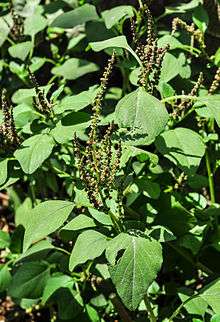Amaranthus viridis
| Amaranthus viridis | |
|---|---|
 | |
| Scientific classification | |
| Kingdom: | Plantae |
| (unranked): | Angiosperms |
| (unranked): | Eudicots |
| (unranked): | Core eudicots |
| Order: | Caryophyllales |
| Family: | Amaranthaceae |
| Genus: | Amaranthus |
| Species: | A. viridis |
| Binomial name | |
| Amaranthus viridis L. | |
Amaranthus viridis is a cosmopolitan species in the botanical family Amaranthaceae and is commonly known as slender amaranth or green amaranth.
Description
A. viridis is an annual herb with an upright, light green stem that grows to about 60–80 cm in height. Numerous branches emerge from the base, and the leaves are ovate, 3–6 cm long, 2–4 cm wide, with long petioles of about 5 cm. The plant has terminal panicles with few branches, and small green flowers with 3 stamens.[1]
Uses
Amaranthus viridis is eaten in Northeastern Indian state Manipur where it is known as Cheng-kruk and eaten traditionally as a vegetable in South India, especially in Kerala, where it is known as "Kuppacheera" കുപ്പച്ചീര. It is a common vegetable in Bengali cuisine and is called "note shak" ("shak" means leafy vegetable).
In Greece it is called vlita (βλήτα) and is one of the varieties of "horta" or greens known in Greek cuisine which are boiled and served with olive oil and lemon.
It is also eaten as a vegetable in parts of Africa.[2] In Jamaica it is eaten as a vegetable and is known locally as callaloo (not to be confused with callaloo of most other countries). The leaves of this plant, known as massaagu in Dhivehi, have been used in the diet of the Maldives for centuries in dishes such as mas huni.[3]
In the 19th Century A. viridus, or green amaranth was an item of food in Australia. The botanist Joseph Maiden wrote in 1889: "It is an excellent substitute for spinach, being far superior to much of the leaves of the white beet sold for spinach in Sydney. Next to spinach it seems to be most like boiled nettle leaves, which when young are used in England, and are excellent. This amarantus should be cooked like spinach, and as it becomes more widely known, it is sure to be popular, except amongst persons who may consider it beneath their dignity to have anything to do with so common a weed."[4]
Green amaranth also has clusters of nutty edible seeds, which can be eaten as snacks or used in biscuits. A porridge can be made by boiling the seeds in water. Unlike other amaranths, the seeds can be easily harvested by scraping the ripe spikes of seeds between the fingers.[4]
Amaranthus viridis is used as a medicinal herb in traditional Ayurvedic medicine, under the Sanskrit name Tanduliya.[5]
References
- ↑ Tanaka, Yoshitaka; Van Ke, Nguyen (2007). Edible Wild Plants of Vietnam: The Bountiful Garden. Thailand: Orchid Press. p. 24. ISBN 9745240893.
- ↑ Grubben, G.J.H. & Denton, O.A. (2004) Plant Resources of Tropical Africa 2. Vegetables. PROTA Foundation, Wageningen; Backhuys, Leiden; CTA, Wageningen.
- ↑ Xavier Romero-Frias, The Maldive Islanders, A Study of the Popular Culture of an Ancient Ocean Kingdom. Barcelona 1999, ISBN 84-7254-801-5
- 1 2 Low, Tim (1985). Wild Herbs of Australia & New Zealand. Angus & Robertson Publishers. p. 44. ISBN 0207151679.
- ↑ R.V. Nair, Controversial drug plants
External links
- PROTAbase on Amaranthus viridis
- photograph, description and diagram from HerbiGuide
| Wikimedia Commons has media related to Amaranthus viridis. |
| Wikispecies has information related to: Amaranthus viridis |